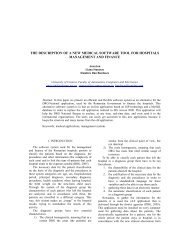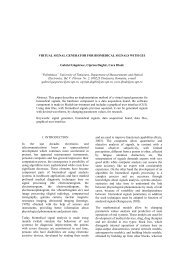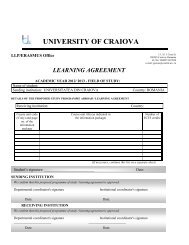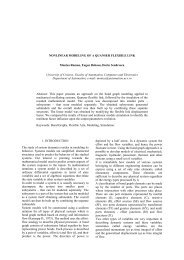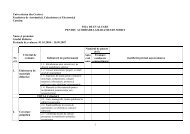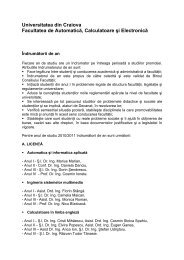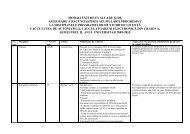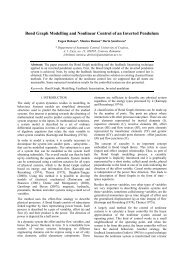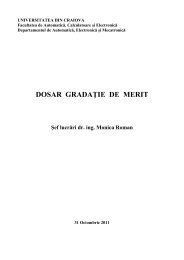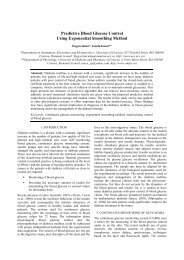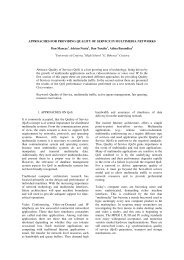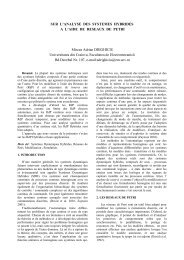Bioprocesses parameters control in the case of a BIOSTAT A PLUS ...
Bioprocesses parameters control in the case of a BIOSTAT A PLUS ...
Bioprocesses parameters control in the case of a BIOSTAT A PLUS ...
You also want an ePaper? Increase the reach of your titles
YUMPU automatically turns print PDFs into web optimized ePapers that Google loves.
The success <strong>of</strong> biotechnological experiments depends on<br />
<strong>the</strong> optimal growth conditions <strong>of</strong> <strong>the</strong> micro-organisms <strong>in</strong><br />
<strong>the</strong> created bioreactor. The cells are constantly struggl<strong>in</strong>g<br />
with changes <strong>in</strong> <strong>the</strong> culture, <strong>in</strong> order to obta<strong>in</strong> and<br />
ma<strong>in</strong>ta<strong>in</strong> optimal growth conditions. (Petre, 2008).<br />
The bioreactor <strong>control</strong> must ensure <strong>the</strong> cont<strong>in</strong>uous supply<br />
<strong>of</strong> cells with appropriate resources used for growth or<br />
production <strong>of</strong> metabolites, ensur<strong>in</strong>g also optimum values<br />
for pH, temperature, substrate concentration, m<strong>in</strong>eral salts<br />
concentration, growth factors and oxygen concentration<br />
(Petre and Selisteanu, 2005).<br />
The paper is organized as follows. In Section 2 <strong>the</strong><br />
technical features <strong>of</strong> <strong>the</strong> <strong>BIOSTAT</strong> A <strong>PLUS</strong> bioreactor<br />
are presented. Section 3 conta<strong>in</strong>s some experiments<br />
regard<strong>in</strong>g <strong>the</strong> <strong>control</strong> <strong>of</strong> <strong>the</strong> temperature, section 4 details<br />
<strong>the</strong> problems regard<strong>in</strong>g <strong>the</strong> <strong>control</strong> <strong>of</strong> <strong>the</strong> stirrer speed and<br />
section 5 deals with pH and pO 2 <strong>control</strong>.<br />
2. THE TECHNICAL FEATURES OF <strong>BIOSTAT</strong> A<br />
<strong>PLUS</strong> BIOREACTOR<br />
The reactor used <strong>in</strong> this paper is a Biostat A Plus<br />
bioreactor, a product from Sartorius Sepadim Company.<br />
In Fig. 1 <strong>the</strong> entire package Biostat A Plus bioreactor is<br />
presented. The equipment conta<strong>in</strong>s three components: an<br />
autoclaved bioreactor, a <strong>control</strong> unit and a s<strong>of</strong>tware<br />
application that can <strong>control</strong> different <strong>parameters</strong> like<br />
temperature, pH, pO 2 , stirrer velocity or different gas<br />
flows (<strong>BIOSTAT</strong>, 2006).<br />
Fig. 1. Biostat A Plus Bioreactor (<strong>BIOSTAT</strong>, 2006).<br />
The communication between <strong>the</strong> <strong>control</strong> unit and <strong>the</strong><br />
laptop that conta<strong>in</strong>s <strong>the</strong> microDCU MFCS/DA s<strong>of</strong>tware<br />
(Multi Fermenter Control System – Data Acquisition) is<br />
realised by us<strong>in</strong>g <strong>the</strong> E<strong>the</strong>rnet TCP/IP protocol<br />
(<strong>BIOSTAT</strong>, 2006). E<strong>the</strong>rnet is a broadcast network<br />
designed for local area networks. E<strong>the</strong>rnet became <strong>the</strong><br />
most popular technology based on Layer 2 (can take<br />
forward<strong>in</strong>g decisions based on MAC address) because it<br />
is best suited for <strong>the</strong> occasional network traffic (Iancu,<br />
2004).<br />
2.1 Bioreactor description<br />
The culture vessel used for experiments has a volume <strong>of</strong> 5<br />
litres and it is made <strong>of</strong> borosilicate glass that can be<br />
heated up to approximately 80°C by an electrical blanket<br />
(<strong>BIOSTAT</strong>, 2006).<br />
Autoclave sterilization <strong>of</strong> <strong>the</strong> vessel and its components is<br />
done at a temperature <strong>of</strong> 121°C (<strong>BIOSTAT</strong>, 2006).<br />
The vessel lid is made <strong>of</strong> sta<strong>in</strong>less steel and has holes <strong>of</strong><br />
different diameters for <strong>in</strong>troduc<strong>in</strong>g <strong>the</strong> stirrer, tubes for<br />
<strong>in</strong>troduc<strong>in</strong>g <strong>the</strong> substances and probes for pH, pO 2 ,<br />
temperature, antifoam/level measurement (<strong>BIOSTAT</strong>,<br />
2006).<br />
The homogeneity <strong>of</strong> culture is realised by <strong>the</strong> stirrer and<br />
consists <strong>in</strong> a drive that rotates an arbour. A helicoidally<br />
paddle is attached to <strong>the</strong> arbour. All components that are<br />
<strong>in</strong> direct contact with <strong>the</strong> culture are made <strong>of</strong> sta<strong>in</strong>less<br />
steel (<strong>BIOSTAT</strong>, 2006).<br />
The stirrer <strong>of</strong> <strong>the</strong> cell culture version bioreactor consists<br />
<strong>of</strong> three coaxial segments and ensures a slide and<br />
effective mixture (<strong>BIOSTAT</strong>, 2006).<br />
In <strong>the</strong> bioreactor’s field <strong>the</strong> temperature can be <strong>control</strong>led<br />
<strong>in</strong> several ways. For example, <strong>in</strong> <strong>the</strong> <strong>case</strong> <strong>of</strong> double-wall<br />
vessels <strong>the</strong> temperature is <strong>control</strong>led by a system <strong>of</strong><br />
serpent<strong>in</strong>es through which <strong>the</strong> water runs (<strong>BIOSTAT</strong>,<br />
2006).<br />
In <strong>the</strong> <strong>case</strong> <strong>of</strong> <strong>the</strong> presented bioreactor with a s<strong>in</strong>gle wall<br />
vessel, <strong>the</strong> <strong>control</strong> <strong>of</strong> temperature is done with <strong>the</strong> help <strong>of</strong><br />
a heat<strong>in</strong>g blanket that consists <strong>of</strong> an electrical serpent<strong>in</strong>e<br />
covered with a layer <strong>of</strong> silicone rubber foam. When <strong>the</strong><br />
temperature <strong>in</strong> <strong>the</strong> vessel decreases bellow <strong>the</strong> reference<br />
value, <strong>the</strong> blanket starts heat<strong>in</strong>g. The major disadvantage<br />
is <strong>the</strong> necessity <strong>of</strong> a separated system for cool<strong>in</strong>g <strong>the</strong><br />
bioreactor (<strong>BIOSTAT</strong>, 2006).<br />
2.2 Control Unit<br />
The <strong>control</strong> unit is characterized by an <strong>in</strong>tegrated <strong>control</strong><br />
system, <strong>in</strong>tegrated pumps, gas flow <strong>control</strong>lers, <strong>control</strong> for<br />
pH/DO and foam/level (<strong>BIOSTAT</strong>, 2006).<br />
For <strong>the</strong> <strong>control</strong> unit it is necessary to use an external<br />
computer. This also <strong>of</strong>fers <strong>the</strong> possibility <strong>of</strong> a touch panel<br />
attachment and development <strong>of</strong> s<strong>of</strong>tware for manag<strong>in</strong>g /<br />
monitor<strong>in</strong>g process (<strong>BIOSTAT</strong>, 2006).<br />
In <strong>the</strong> frontal part <strong>of</strong> <strong>the</strong> unit <strong>the</strong>e exist three peristaltic<br />
pumps that can be l<strong>in</strong>ked to <strong>the</strong> acid, base and<br />
antifoam/level bottle (<strong>BIOSTAT</strong>, 2006).<br />
3. TEMPERATURE CONTROL<br />
To <strong>control</strong> <strong>the</strong> process temperature, first we must<br />
determ<strong>in</strong>e <strong>the</strong> process model, <strong>in</strong> particular <strong>the</strong> transfer<br />
function that describes this process. To do this we<br />
developed an experiment, more exactly a bioreactor<br />
heat<strong>in</strong>g test that gives us <strong>the</strong> possibility to identify <strong>the</strong><br />
<strong>parameters</strong> <strong>of</strong> <strong>the</strong> transfer function. The dynamics <strong>of</strong> <strong>the</strong><br />
system is studied by us<strong>in</strong>g signal acquisition from <strong>the</strong><br />
temperature sensor <strong>in</strong>side <strong>the</strong> vessel and from its<br />
graphical representation by us<strong>in</strong>g <strong>the</strong> micro-DCU.<br />
The <strong>the</strong>rmodynamics <strong>the</strong>ory claims that <strong>the</strong> heat<strong>in</strong>g<br />
process tak<strong>in</strong>g place <strong>in</strong>side an enclosure can be



